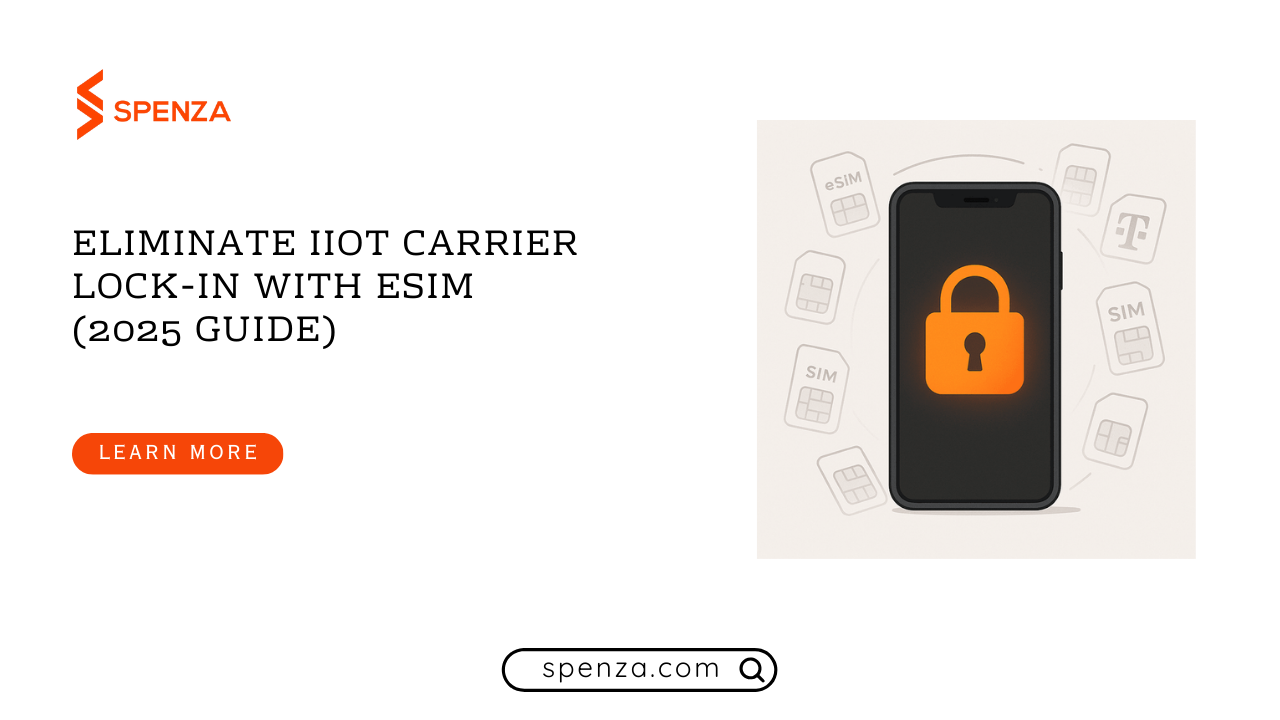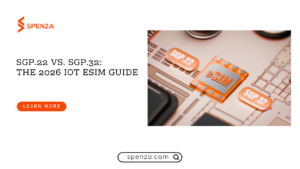TL;DR — Why Carrier Lock-In Is a Strategic Risk in IIoT
- Industrial assets live 10–20 years, but carrier contracts, radio tech, and regulations change every few years.
- Physical SIMs hard-wire you to one MNO, creating coverage gaps, price lock, roaming headaches, network-sunset risk, and truck-roll costs at scale.
- eSIM (eUICC + Remote SIM Provisioning) turns connectivity into software: you can load multiple MNO profiles and switch over the air.
- New GSMA SGP.32 finally puts profile control in the enterprise’s hands, not the incumbent carrier.
- Spenza platform that not only enables this new eSIM future but also provides a “single pane of glass” to manage the crucial transition from legacy physical SIM fleets.
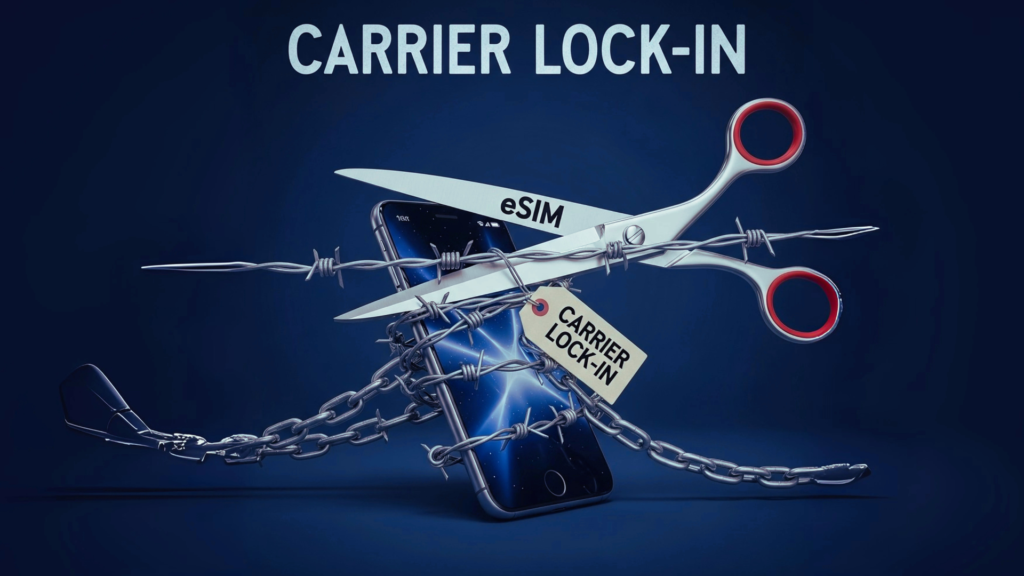
What “IIoT Carrier Lock-In” Really Means
Lock-in isn’t just a contract. It’s a technical dependency on one carrier’s core and coverage footprint for your device’s entire life. When the device identity is fused to a single MNO via a physical SIM, the fleet inherits that MNO’s outages, pricing, and roadmap. In long-life cycle IIoT, that’s a single point of failure (SPOF) for operations and finances and a “monoculture” security posture.
Where Lock-In Bites (4 Industrial Use Cases)
- Smart Metering: 10–15 year lifecycles collide with network sunsets and price changes. A 3G/4G-only meter can be stranded mid-life if the network is refarmed, requiring costly field swaps.
- Remote Tank Monitoring: Remote locations + patchy coverage. Single-MNO devices go dark in dead zones; eSIM can fail over to a stronger local MNO.
- Industrial Pumps/HVAC: Hard-to-reach installs (rooftops, ceilings). Any SIM change equals a truck roll and multiplied across thousands.
- Connected Generators: Long service life + evolving bands/LPWAN variants (LTE-M/NB-IoT). Without profile agility, you’re stuck on “yesterday’s network.”
The Hidden Costs of Carrier Lock-In

When your industrial devices are tied to a single carrier with a physical SIM card, you’re exposed to serious risks that can cripple your operations and budget. Here’s what that means in simple terms:
1. Your Devices Can Become Expensive Paperweights
Carriers eventually shut down older networks (like 3G and 4G) to make way for newer ones. If your device has a 15-year lifespan but is locked to a 4G network, it becomes a useless “bricked” asset when that network is retired in year eight.
Your only option is an incredibly expensive mission to physically replace the SIM in every single device.
2. You’re Trapped in Costly, Inflexible Contracts
Once your devices are deployed in the field, you lose all negotiating power. You’re stuck with your carrier’s pricing for the life of the asset, even if they raise rates or more competitive offers become available.
Furthermore, if your devices need to operate in different regions, you’re forced to rely on complex and expensive roaming agreements.
3. You’re at the Mercy of One Carrier’s Coverage
No single carrier provides 100% perfect coverage everywhere. If your devices are in an area where your chosen provider has a weak signal, they simply go offline, leading to unreliable data and operational gaps.
Resolving these issues often requires dispatching technicians to remote sites, a costly process known as a “truck roll“.
4. Your Entire Fleet Shares a Single Point of Failure
Relying on one network for all your devices creates a security “monoculture“. If that single carrier experiences a technical outage or a cyberattack, your entire fleet of devices could be knocked offline simultaneously. This concentrates all your operational risk in one basket, which can have devastating consequences.
It might feel a bit panic-inducing to realize how stuck you are with your current carrier but the good news is, there’s a way out: eSIM and Remote SIM Provisioning (RSP) are changing the game.
The Solution: How eSIM and Remote SIM Provisioning (RSP) Break the Chains
In response to these limitations, the industry developed the embedded SIM (eSIM). Unlike a removable plastic SIM card, an eSIM for IIoT is a rugged, built-in chip inside industrial devices that can store multiple mobile carrier profiles.
The real magic? These profiles can be switched remotely, over the air, without ever needing physical access, making it ideal for machines deployed in hard-to-reach or global locations.
The real innovation lies in two related concepts:
- eUICC(Embedded Universal Integrated Circuit Card): This is the secure software on the eSIM that can store multiple operator profiles at once. Think of it as a digital wallet for network identities.
- Remote SIM Provisioning (RSP): This is the globally standardized process for remotely managing the profiles on the eUICC over-the-air (OTA). It’s the engine that allows you to add a new carrier, switch between carriers, or remove a profile from any device, anywhere in the world.
You get carrier choice, multi-profile resilience, single global SKU, and “no-truck-roll” lifecycle ops.
Why the GSMA SGP.32 Standard is a Game-Changer
The most crucial development for IIoT is the new GSMA SGP.32 standard. Previous standards were carrier-centric, meaning your existing carrier held the keys to any switch, creating a form of “digital lock-in.“
SGP.32 fundamentally re-architects the ecosystem to put control directly into the hands of the enterprise. It introduces an
eSIM IoT Manager (eIM), a remote management tool you control, not the MNO. This standard was specifically designed to be lightweight and efficient, making it ideal for the massive-scale, low-power deployments that define the IIoT landscape.
This change finally delivers on the promise of true carrier independence.
The Tangible Business Benefits of an eSIM-First Strategy
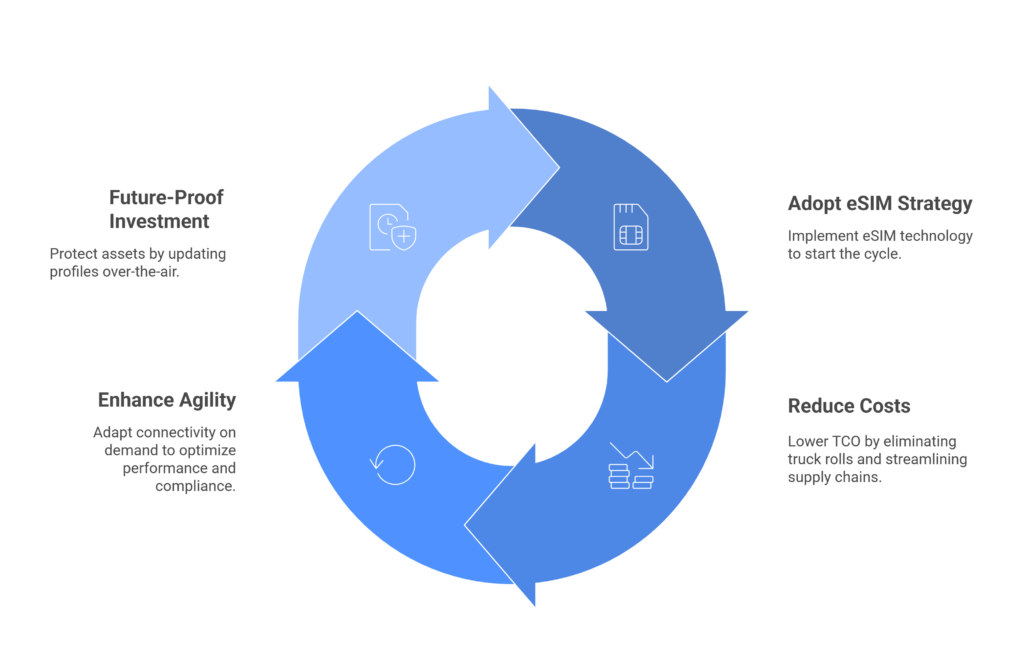
Adopting an eSIM-first strategy, governed by the SGP.32 standard, translates directly into powerful business advantages.
1. Radical Cost Reduction: Transforming your Total Cost of Ownership (TCO)
While an eSIM component may have a slightly higher upfront cost, the long-term TCO savings are immense. You can eliminate costly truck rolls for all connectivity-related issues and streamline your supply chain by manufacturing a single global SKU of your product, downloading the correct local carrier profile at the time of deployment.
2. Unprecedented Agility: Adapting Connectivity on Demand
eSIM transforms connectivity from a fixed attribute into a flexible resource. You can remotely switch carriers to optimize for better coverage, more competitive pricing, or higher performance. This also allows you to seamlessly adapt to changing international regulations, such as bans on permanent roaming, by downloading a local, compliant profile on the fly.
3. True Future-Proofing: Protecting Your Investment for Decades
This is the most critical benefit for long-lifecycle assets. An MNO’s decision to sunset its 4G network will not render your eSIM-equipped device obsolete. You can simply push a new 5G profile over-the-air, decoupling your hardware’s lifespan from the much shorter lifecycle of network technologies and protecting your capital investment.
Traditional SIM vs. eSIM – Capabilities Comparison
| Feature | Traditional SIM | eSIM with Management Platform |
|---|---|---|
| Carrier Flexibility | Locked to a single carrier. | Dynamic. Switch carriers remotely on demand. |
| Lifecycle Management | Requires expensive “truck rolls” for any change. | Managed centrally from a single platform. |
| Global Logistics | Requires multiple SKUs and complex inventory. | Enables a single global SKU. |
| Future-Proofing | Vulnerable to network sunsets. | Adaptable via OTA updates for new networks (e.g., 5G). |
Lifecycle Total Cost of Ownership (TCO) — Illustrative Model
Assumptions (illustrative, adjust to your ops):
Fleet: 10,000 devices; analysis horizon: 10 years; average truck-roll cost (crew, access, downtime coordination): $300; SIM handling+logistics per device change: $25; annual roaming uplift vs local: $12/device; 2 reactive field visits per 100 devices over 10 years for single-MNO coverage gaps.
| Cost Driver (10 yrs) | Fixed SIM (single MNO) | eSIM (multi-MNO, RSP) |
|---|---|---|
| Initial SKUs & logistics | Multi-SKU complexity (per-region) | One global SKU (simplified) |
| Field SIM swaps | ~200 visits × $300 = $60,000 | $0 (profile OTA) |
| SIM handling (field swaps) | 200 × $25 = $5,000 | $0 |
| Roaming uplift | $1.2M (if roaming used) | Localize profiles, significantly reduced |
| Outage/coverage remediation | Ad-hoc; reactive | Policy-based failover to backup profile |
| Total (illustrative) | Higher, unpredictable | Lower, controllable |
Beyond line items, eSIM’s biggest savings are avoiding downtime and commercial leverage (you can move traffic to competitive plans). Your mileage will vary, but the direction of travel is clear.
eSIM with Remote SIM Provisioning doesn’t just make technical sense—it makes business sense. From simplified logistics to reduced roaming costs and fewer field interventions, the long-term ROI is hard to ignore.
What to Watch Out For
- Hardware readiness: Ensure your modem + eUICC supports the profiles you need (e.g., LTE-M/NB-IoT bands) and industrial MFF2 packaging.
- MNO cooperation & standards: Some carriers still operate SGP.02 paths; SGP.32 support is the target — verify timelines and integration model for your footprint.
- Bootstrap strategy: Plan for first-power connectivity: bootstrap profile, credentialing, and secure fallback if the primary SM-DP is unreachable.
- Policy design: Define clear “failover” thresholds and guardrails to avoid ping-ponging between profiles.
- Ops observability: Without SIM slots to pull, you need platform-level telemetry, alerts, and reconciliation (usage vs plan). That’s where connectivity enablement platforms matter.
Why Spenza for Industrial eSIM
Spenza is an operator-neutral connectivity enablement platform that provides the crucial orchestration layer needed to unlock the full potential of eSIM.
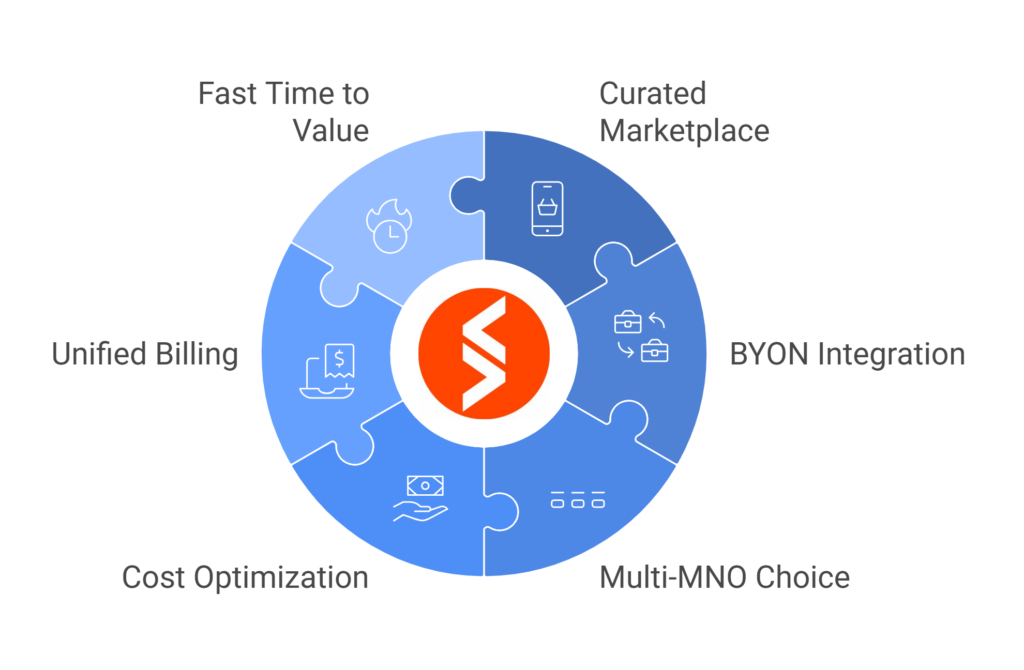
Instead of juggling dozens of different carrier portals, Spenza offers a “single pane of glass” to manage everything from legacy physical SIMs to new eSIMs through a unified dashboard. With Spenza, you can:
- Access a Curated Marketplace: Procure customizable mobile plans from leading operators worldwide, without the hassle of complex, individual negotiations.
- Bring Your Own Network (BYON): Integrate your existing carrier contracts and manage them alongside new services giving you ultimate flexibility and control.
- Multi-MNO Choice & Policy-Based Control: Select local carriers per region, set backup profiles, and automate failover for improved reliability.
- Cost Optimization & Wireless Expense Management (WEM): Consolidate contracts and invoices across operators, enforce policy, and cut wireless spend. (savings of up to ~30%.)
- One Platform, One Bill: Enjoy streamlined procure-to-pay workflows and unified inventory management across devices, SIMs, and subscriptions.
- Fast Time to Value: Spenza’s no-code components and pre-integrations like Shopify help brands launch quickly.
Use Case in Action: Smart Metering Deployment
Let’s see how this works in a real-world scenario.
The Scenario: A global utility company deploys 500,000 smart meters, each with an expected 15-year operational life.
With Traditional SIMs: The meters are deployed with 4G SIM cards from a single national carrier. In year 8, that carrier announces it will sunset its 4G network within 24 months to reallocate spectrum for 6G. The utility now faces a catastrophic choice: write off millions of dollars in perfectly functional hardware or spend tens of millions on a massive truck roll campaign to physically replace every single SIM card.
With eSIM + Spenza: The utility deploys meters with eSIMs managed on the Spenza platform. When the 4G sunset is announced, the operations team uses the Spenza dashboard to remotely and securely push a new 5G-compliant profile from a different carrier to the entire fleet over-the-air. The transition is seamless, with zero truck rolls, ensuring 100% service continuity and safeguarding the entire hardware investment.
Roadmap to Eliminating Carrier Lock-In
Migrating to an eSIM-first strategy is a strategic initiative. Here’s a simple roadmap to get started:
- Evaluate Your Foundation: Assess your current device hardware for eUICC compatibility and review your existing connectivity contracts to identify upcoming points of inflexibility.
- Choose a Platform-First Partner: Select a connectivity management partner(Spenza) whose platform is operator-neutral, supports the new SGP.32 standard, and can manage your entire SIM lifecycle.
- Deploy with Confidence: Develop a phased rollout strategy. Start with a proof-of-concept on a new deployment to validate the technology and processes before scaling fleet-wide.
Conclusion: Own Your Connectivity, Own Your Future
In today’s evolving technological landscape, carrier lock-in is no longer a necessity—it’s a choice. Clinging to the old model of physical, single-carrier SIMs exposes your organization to unacceptable levels of financial, operational, and technological risk.
eSIM technology provides freedom, and the new SGP.32 standard puts the controls firmly in your hands. But it is a powerful connectivity management platform like Spenza that provides the strategy, turning that raw capability into a powerful competitive advantage. The future of the Industrial IoT is flexible, resilient, and enterprise-controlled.
FAQs
You can still operate via older flows, but plan for SGP.32 migration, it moves control from the carrier to you and scales better for headless IIoT.
Yes. Spenza supports BYON alongside its marketplace so you can mix and match carriers and plans in one place.
Yes but confirm the radio module + eUICC + MNO profile combo for your target markets. Plan wake/sleep + trigger mechanisms carefully.
Industries like logistics, healthcare, energy, manufacturing, and smart cities see the greatest benefits because their operations rely heavily on uninterrupted connectivity.
Typically, you can launch in 7 days. Usually it takes days, not months.
Ready to de-risk your IIoT deployments and take full control of your global connectivity? Schedule a free demo with a Spenza expert today.

